Microeconomic Principles and Their Impact on Business Operations
VerifiedAdded on 2021/04/24
|20
|4064
|64
Report
AI Summary
This report delves into the application of microeconomic principles within a business context. It begins by establishing the importance of economics in business decision-making, emphasizing the impact of resource scarcity. The report then explores key microeconomic concepts such as demand, supply, and elasticity, providing graphical representations and explanations of their dynamics. The law of demand, income effect, and substitution effect are analyzed in detail, along with exceptions to the law. The report also examines the factors influencing demand and supply, and how businesses can use these insights to make informed decisions regarding pricing, production, and market equilibrium. Furthermore, the report touches on market structures, providing a comprehensive overview of how microeconomic principles affect business operations and strategic planning. The analysis uses figures and diagrams to illustrate key concepts and their implications for commercial organizations in the global economy.
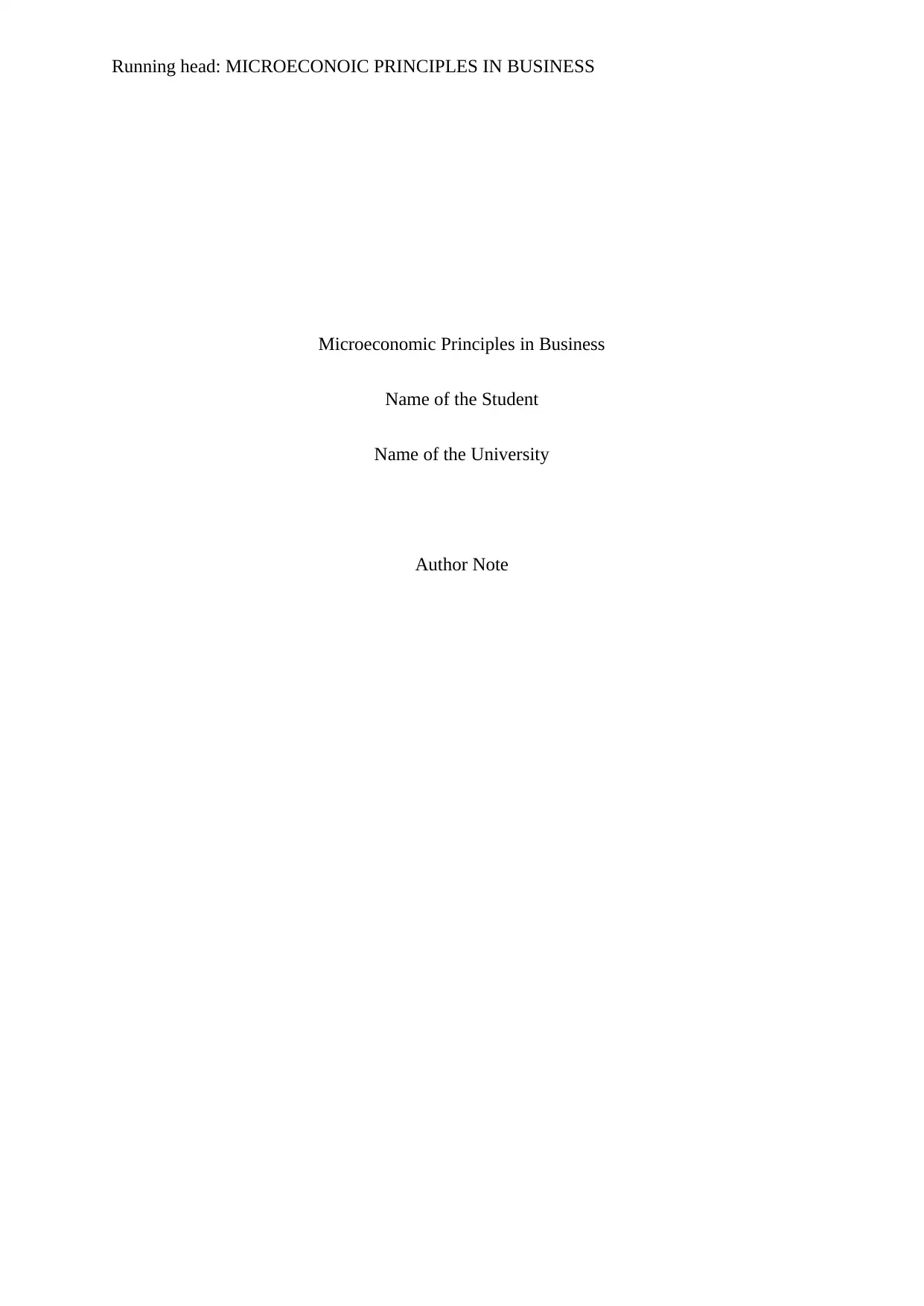
Running head: MICROECONOIC PRINCIPLES IN BUSINESS
Microeconomic Principles in Business
Name of the Student
Name of the University
Author Note
Microeconomic Principles in Business
Name of the Student
Name of the University
Author Note
Paraphrase This Document
Need a fresh take? Get an instant paraphrase of this document with our AI Paraphraser
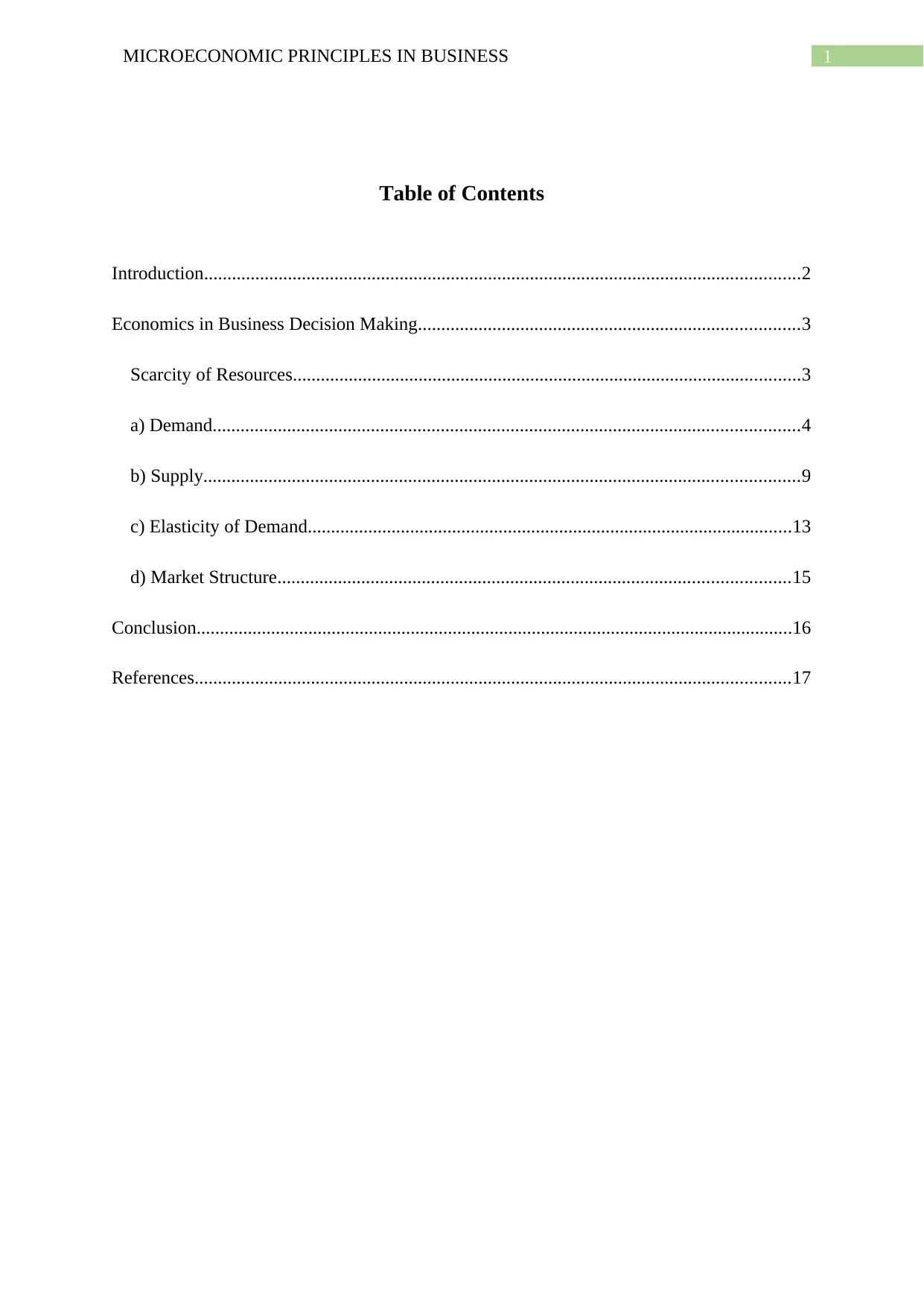
1MICROECONOMIC PRINCIPLES IN BUSINESS
Table of Contents
Introduction................................................................................................................................2
Economics in Business Decision Making..................................................................................3
Scarcity of Resources.............................................................................................................3
a) Demand..............................................................................................................................4
b) Supply................................................................................................................................9
c) Elasticity of Demand........................................................................................................13
d) Market Structure..............................................................................................................15
Conclusion................................................................................................................................16
References................................................................................................................................17
Table of Contents
Introduction................................................................................................................................2
Economics in Business Decision Making..................................................................................3
Scarcity of Resources.............................................................................................................3
a) Demand..............................................................................................................................4
b) Supply................................................................................................................................9
c) Elasticity of Demand........................................................................................................13
d) Market Structure..............................................................................................................15
Conclusion................................................................................................................................16
References................................................................................................................................17
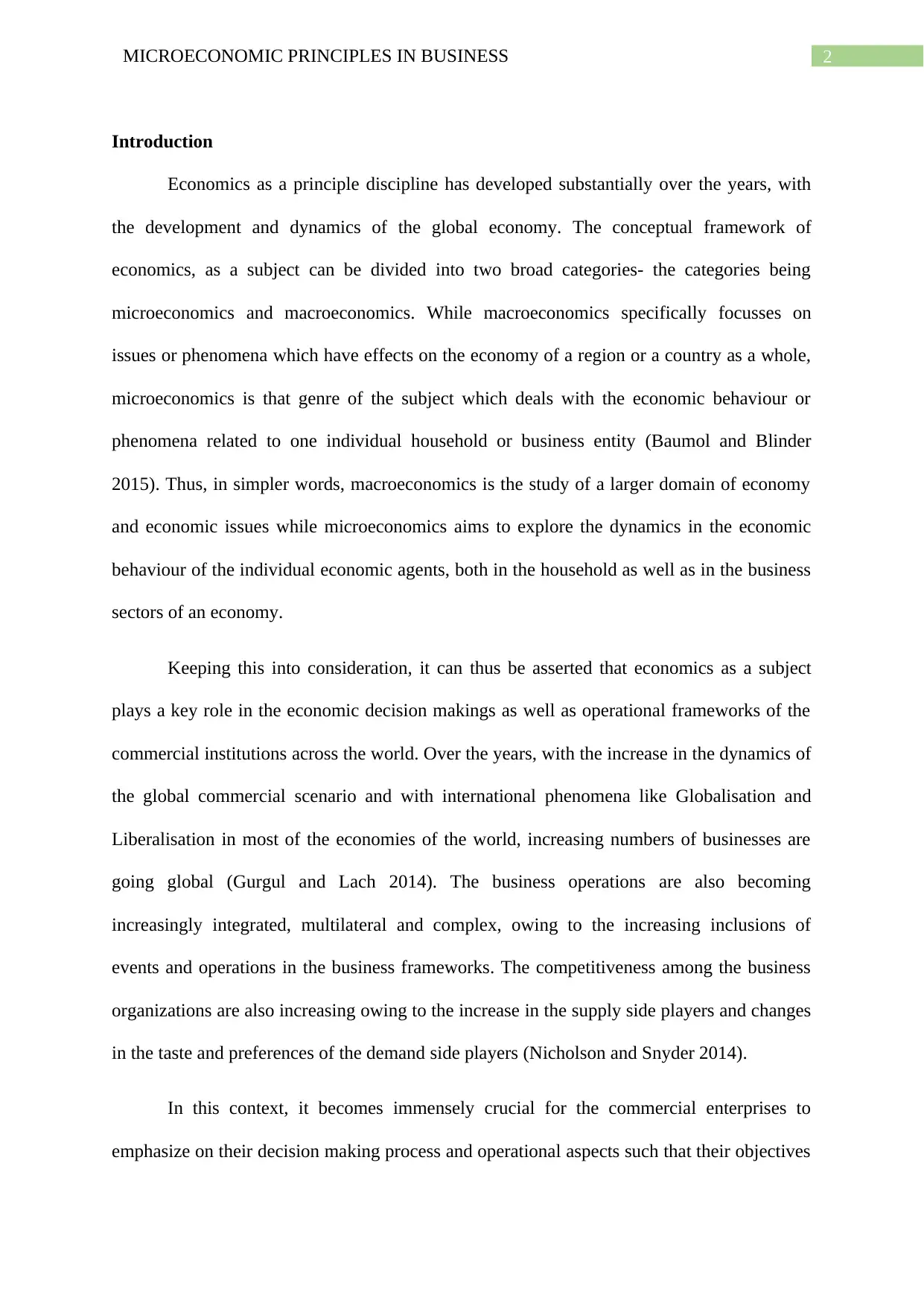
2MICROECONOMIC PRINCIPLES IN BUSINESS
Introduction
Economics as a principle discipline has developed substantially over the years, with
the development and dynamics of the global economy. The conceptual framework of
economics, as a subject can be divided into two broad categories- the categories being
microeconomics and macroeconomics. While macroeconomics specifically focusses on
issues or phenomena which have effects on the economy of a region or a country as a whole,
microeconomics is that genre of the subject which deals with the economic behaviour or
phenomena related to one individual household or business entity (Baumol and Blinder
2015). Thus, in simpler words, macroeconomics is the study of a larger domain of economy
and economic issues while microeconomics aims to explore the dynamics in the economic
behaviour of the individual economic agents, both in the household as well as in the business
sectors of an economy.
Keeping this into consideration, it can thus be asserted that economics as a subject
plays a key role in the economic decision makings as well as operational frameworks of the
commercial institutions across the world. Over the years, with the increase in the dynamics of
the global commercial scenario and with international phenomena like Globalisation and
Liberalisation in most of the economies of the world, increasing numbers of businesses are
going global (Gurgul and Lach 2014). The business operations are also becoming
increasingly integrated, multilateral and complex, owing to the increasing inclusions of
events and operations in the business frameworks. The competitiveness among the business
organizations are also increasing owing to the increase in the supply side players and changes
in the taste and preferences of the demand side players (Nicholson and Snyder 2014).
In this context, it becomes immensely crucial for the commercial enterprises to
emphasize on their decision making process and operational aspects such that their objectives
Introduction
Economics as a principle discipline has developed substantially over the years, with
the development and dynamics of the global economy. The conceptual framework of
economics, as a subject can be divided into two broad categories- the categories being
microeconomics and macroeconomics. While macroeconomics specifically focusses on
issues or phenomena which have effects on the economy of a region or a country as a whole,
microeconomics is that genre of the subject which deals with the economic behaviour or
phenomena related to one individual household or business entity (Baumol and Blinder
2015). Thus, in simpler words, macroeconomics is the study of a larger domain of economy
and economic issues while microeconomics aims to explore the dynamics in the economic
behaviour of the individual economic agents, both in the household as well as in the business
sectors of an economy.
Keeping this into consideration, it can thus be asserted that economics as a subject
plays a key role in the economic decision makings as well as operational frameworks of the
commercial institutions across the world. Over the years, with the increase in the dynamics of
the global commercial scenario and with international phenomena like Globalisation and
Liberalisation in most of the economies of the world, increasing numbers of businesses are
going global (Gurgul and Lach 2014). The business operations are also becoming
increasingly integrated, multilateral and complex, owing to the increasing inclusions of
events and operations in the business frameworks. The competitiveness among the business
organizations are also increasing owing to the increase in the supply side players and changes
in the taste and preferences of the demand side players (Nicholson and Snyder 2014).
In this context, it becomes immensely crucial for the commercial enterprises to
emphasize on their decision making process and operational aspects such that their objectives
⊘ This is a preview!⊘
Do you want full access?
Subscribe today to unlock all pages.

Trusted by 1+ million students worldwide
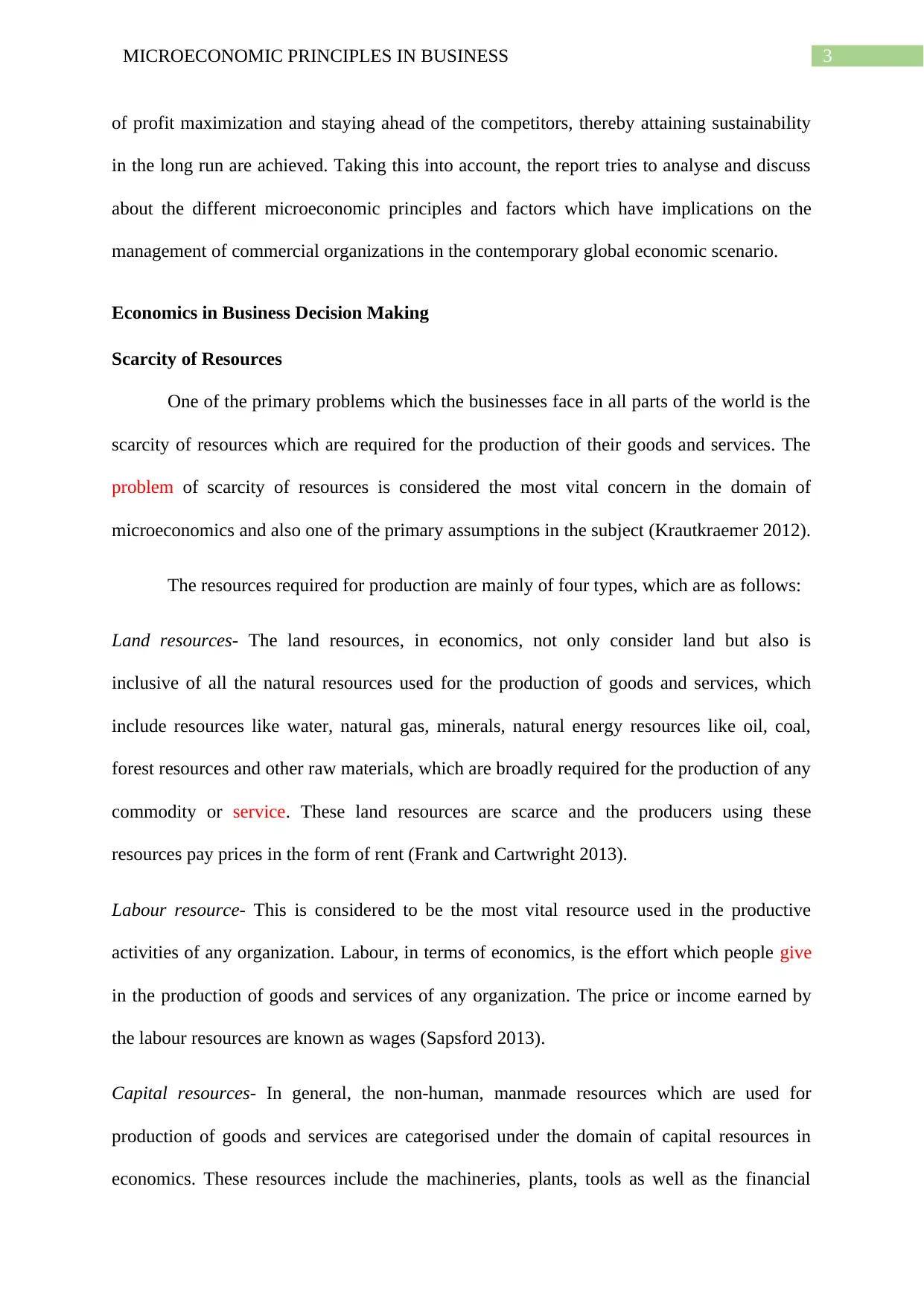
3MICROECONOMIC PRINCIPLES IN BUSINESS
of profit maximization and staying ahead of the competitors, thereby attaining sustainability
in the long run are achieved. Taking this into account, the report tries to analyse and discuss
about the different microeconomic principles and factors which have implications on the
management of commercial organizations in the contemporary global economic scenario.
Economics in Business Decision Making
Scarcity of Resources
One of the primary problems which the businesses face in all parts of the world is the
scarcity of resources which are required for the production of their goods and services. The
problem of scarcity of resources is considered the most vital concern in the domain of
microeconomics and also one of the primary assumptions in the subject (Krautkraemer 2012).
The resources required for production are mainly of four types, which are as follows:
Land resources- The land resources, in economics, not only consider land but also is
inclusive of all the natural resources used for the production of goods and services, which
include resources like water, natural gas, minerals, natural energy resources like oil, coal,
forest resources and other raw materials, which are broadly required for the production of any
commodity or service. These land resources are scarce and the producers using these
resources pay prices in the form of rent (Frank and Cartwright 2013).
Labour resource- This is considered to be the most vital resource used in the productive
activities of any organization. Labour, in terms of economics, is the effort which people give
in the production of goods and services of any organization. The price or income earned by
the labour resources are known as wages (Sapsford 2013).
Capital resources- In general, the non-human, manmade resources which are used for
production of goods and services are categorised under the domain of capital resources in
economics. These resources include the machineries, plants, tools as well as the financial
of profit maximization and staying ahead of the competitors, thereby attaining sustainability
in the long run are achieved. Taking this into account, the report tries to analyse and discuss
about the different microeconomic principles and factors which have implications on the
management of commercial organizations in the contemporary global economic scenario.
Economics in Business Decision Making
Scarcity of Resources
One of the primary problems which the businesses face in all parts of the world is the
scarcity of resources which are required for the production of their goods and services. The
problem of scarcity of resources is considered the most vital concern in the domain of
microeconomics and also one of the primary assumptions in the subject (Krautkraemer 2012).
The resources required for production are mainly of four types, which are as follows:
Land resources- The land resources, in economics, not only consider land but also is
inclusive of all the natural resources used for the production of goods and services, which
include resources like water, natural gas, minerals, natural energy resources like oil, coal,
forest resources and other raw materials, which are broadly required for the production of any
commodity or service. These land resources are scarce and the producers using these
resources pay prices in the form of rent (Frank and Cartwright 2013).
Labour resource- This is considered to be the most vital resource used in the productive
activities of any organization. Labour, in terms of economics, is the effort which people give
in the production of goods and services of any organization. The price or income earned by
the labour resources are known as wages (Sapsford 2013).
Capital resources- In general, the non-human, manmade resources which are used for
production of goods and services are categorised under the domain of capital resources in
economics. These resources include the machineries, plants, tools as well as the financial
Paraphrase This Document
Need a fresh take? Get an instant paraphrase of this document with our AI Paraphraser
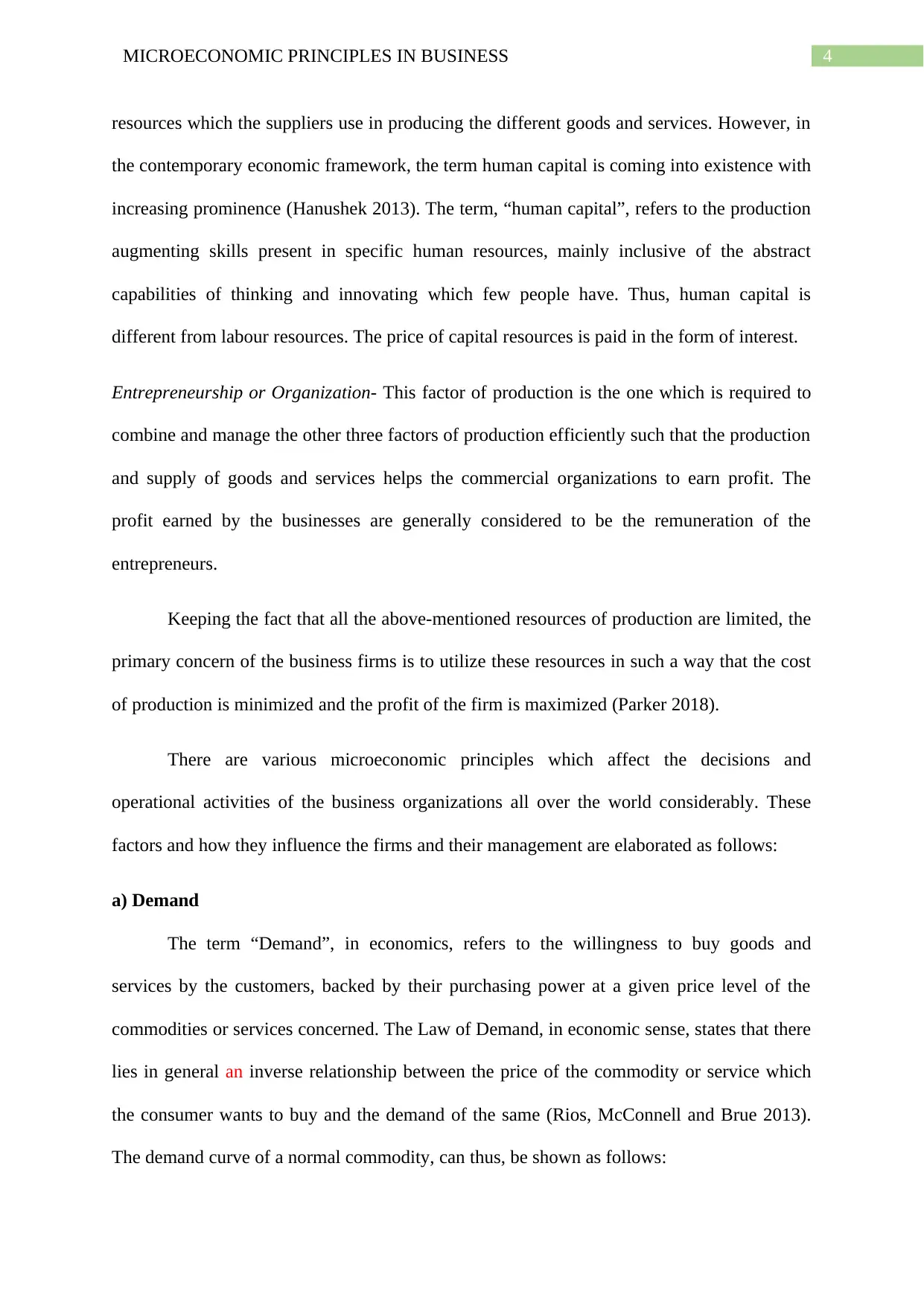
4MICROECONOMIC PRINCIPLES IN BUSINESS
resources which the suppliers use in producing the different goods and services. However, in
the contemporary economic framework, the term human capital is coming into existence with
increasing prominence (Hanushek 2013). The term, “human capital”, refers to the production
augmenting skills present in specific human resources, mainly inclusive of the abstract
capabilities of thinking and innovating which few people have. Thus, human capital is
different from labour resources. The price of capital resources is paid in the form of interest.
Entrepreneurship or Organization- This factor of production is the one which is required to
combine and manage the other three factors of production efficiently such that the production
and supply of goods and services helps the commercial organizations to earn profit. The
profit earned by the businesses are generally considered to be the remuneration of the
entrepreneurs.
Keeping the fact that all the above-mentioned resources of production are limited, the
primary concern of the business firms is to utilize these resources in such a way that the cost
of production is minimized and the profit of the firm is maximized (Parker 2018).
There are various microeconomic principles which affect the decisions and
operational activities of the business organizations all over the world considerably. These
factors and how they influence the firms and their management are elaborated as follows:
a) Demand
The term “Demand”, in economics, refers to the willingness to buy goods and
services by the customers, backed by their purchasing power at a given price level of the
commodities or services concerned. The Law of Demand, in economic sense, states that there
lies in general an inverse relationship between the price of the commodity or service which
the consumer wants to buy and the demand of the same (Rios, McConnell and Brue 2013).
The demand curve of a normal commodity, can thus, be shown as follows:
resources which the suppliers use in producing the different goods and services. However, in
the contemporary economic framework, the term human capital is coming into existence with
increasing prominence (Hanushek 2013). The term, “human capital”, refers to the production
augmenting skills present in specific human resources, mainly inclusive of the abstract
capabilities of thinking and innovating which few people have. Thus, human capital is
different from labour resources. The price of capital resources is paid in the form of interest.
Entrepreneurship or Organization- This factor of production is the one which is required to
combine and manage the other three factors of production efficiently such that the production
and supply of goods and services helps the commercial organizations to earn profit. The
profit earned by the businesses are generally considered to be the remuneration of the
entrepreneurs.
Keeping the fact that all the above-mentioned resources of production are limited, the
primary concern of the business firms is to utilize these resources in such a way that the cost
of production is minimized and the profit of the firm is maximized (Parker 2018).
There are various microeconomic principles which affect the decisions and
operational activities of the business organizations all over the world considerably. These
factors and how they influence the firms and their management are elaborated as follows:
a) Demand
The term “Demand”, in economics, refers to the willingness to buy goods and
services by the customers, backed by their purchasing power at a given price level of the
commodities or services concerned. The Law of Demand, in economic sense, states that there
lies in general an inverse relationship between the price of the commodity or service which
the consumer wants to buy and the demand of the same (Rios, McConnell and Brue 2013).
The demand curve of a normal commodity, can thus, be shown as follows:
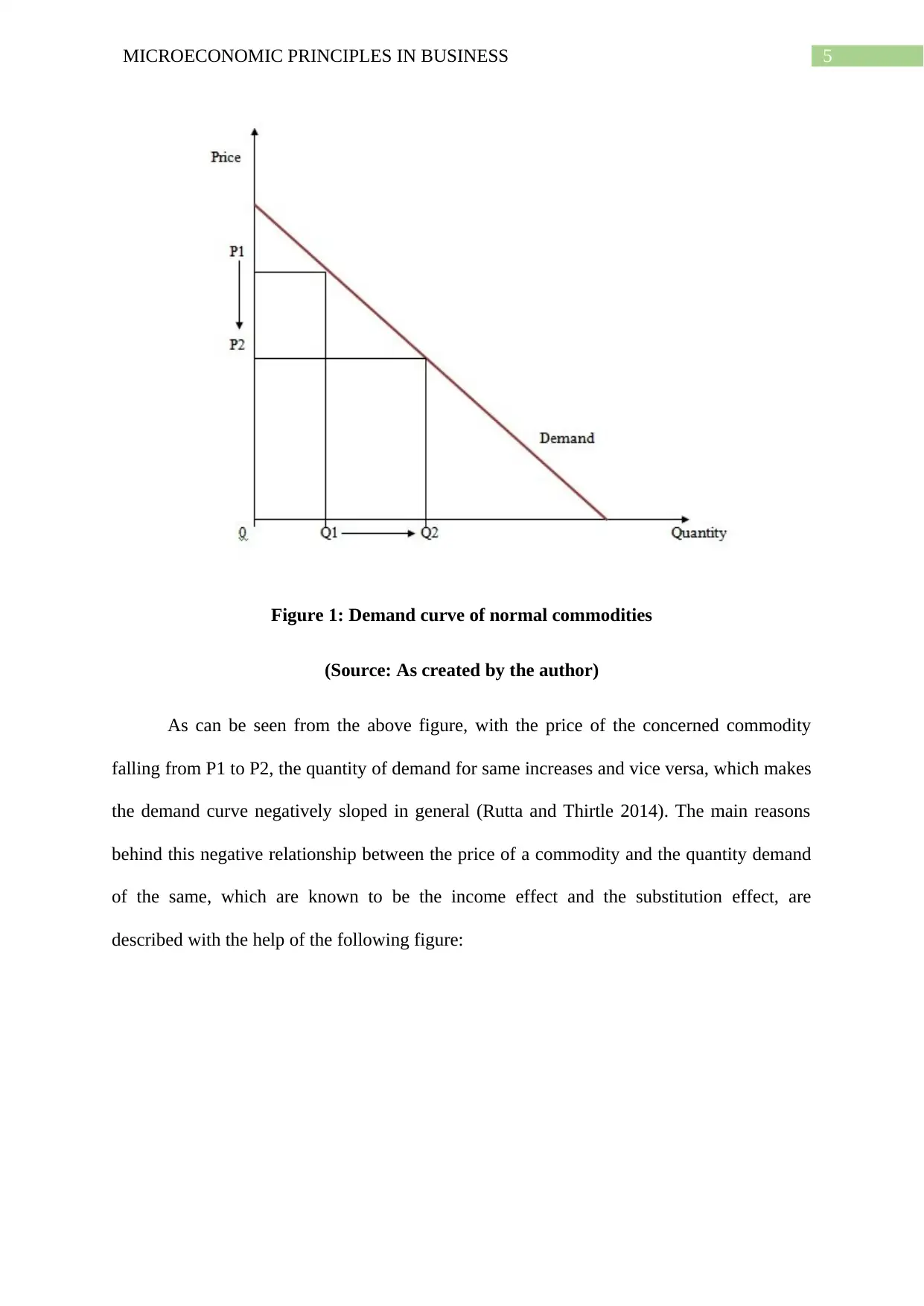
5MICROECONOMIC PRINCIPLES IN BUSINESS
Figure 1: Demand curve of normal commodities
(Source: As created by the author)
As can be seen from the above figure, with the price of the concerned commodity
falling from P1 to P2, the quantity of demand for same increases and vice versa, which makes
the demand curve negatively sloped in general (Rutta and Thirtle 2014). The main reasons
behind this negative relationship between the price of a commodity and the quantity demand
of the same, which are known to be the income effect and the substitution effect, are
described with the help of the following figure:
Figure 1: Demand curve of normal commodities
(Source: As created by the author)
As can be seen from the above figure, with the price of the concerned commodity
falling from P1 to P2, the quantity of demand for same increases and vice versa, which makes
the demand curve negatively sloped in general (Rutta and Thirtle 2014). The main reasons
behind this negative relationship between the price of a commodity and the quantity demand
of the same, which are known to be the income effect and the substitution effect, are
described with the help of the following figure:
⊘ This is a preview!⊘
Do you want full access?
Subscribe today to unlock all pages.

Trusted by 1+ million students worldwide
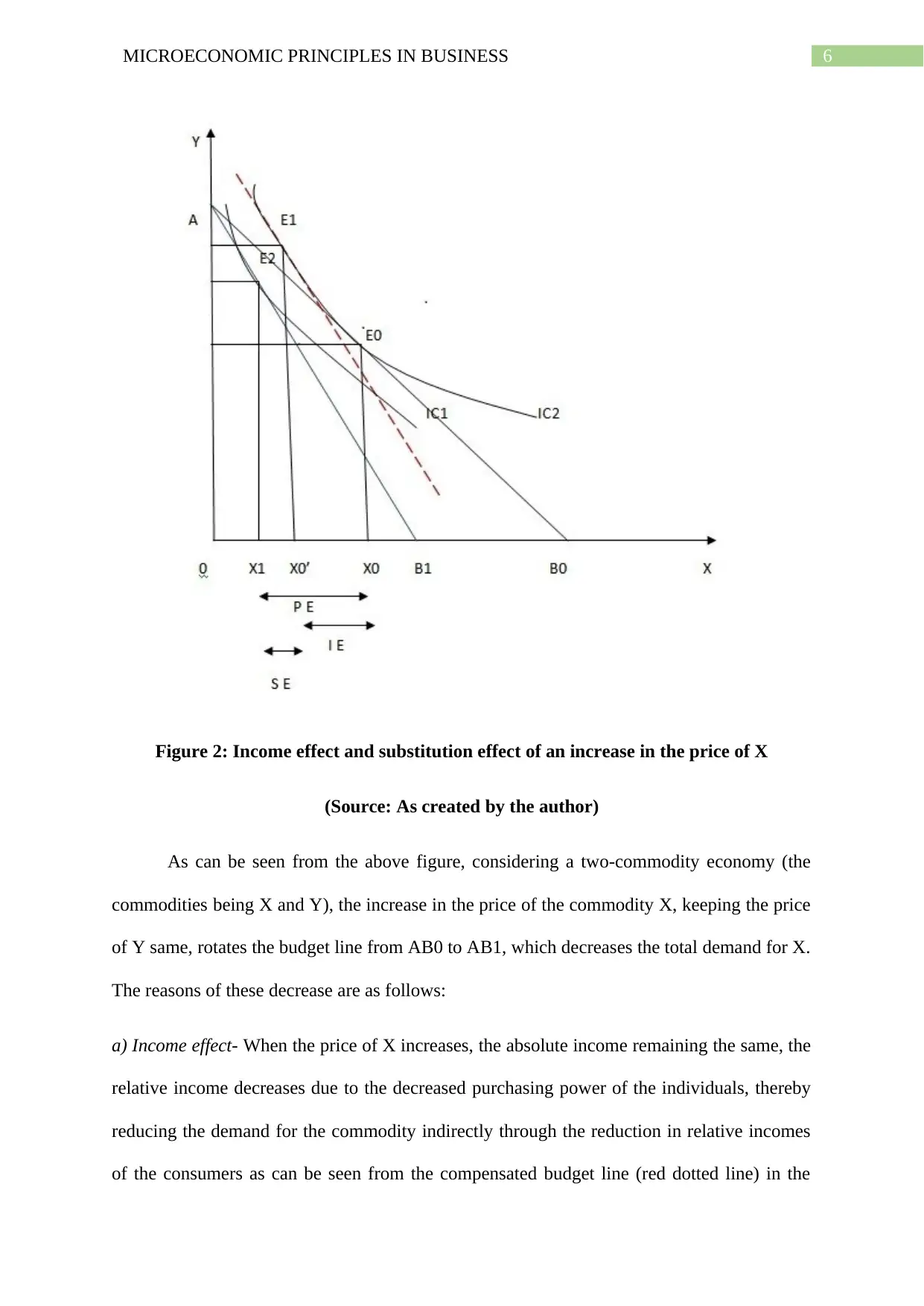
6MICROECONOMIC PRINCIPLES IN BUSINESS
Figure 2: Income effect and substitution effect of an increase in the price of X
(Source: As created by the author)
As can be seen from the above figure, considering a two-commodity economy (the
commodities being X and Y), the increase in the price of the commodity X, keeping the price
of Y same, rotates the budget line from AB0 to AB1, which decreases the total demand for X.
The reasons of these decrease are as follows:
a) Income effect- When the price of X increases, the absolute income remaining the same, the
relative income decreases due to the decreased purchasing power of the individuals, thereby
reducing the demand for the commodity indirectly through the reduction in relative incomes
of the consumers as can be seen from the compensated budget line (red dotted line) in the
Figure 2: Income effect and substitution effect of an increase in the price of X
(Source: As created by the author)
As can be seen from the above figure, considering a two-commodity economy (the
commodities being X and Y), the increase in the price of the commodity X, keeping the price
of Y same, rotates the budget line from AB0 to AB1, which decreases the total demand for X.
The reasons of these decrease are as follows:
a) Income effect- When the price of X increases, the absolute income remaining the same, the
relative income decreases due to the decreased purchasing power of the individuals, thereby
reducing the demand for the commodity indirectly through the reduction in relative incomes
of the consumers as can be seen from the compensated budget line (red dotted line) in the
Paraphrase This Document
Need a fresh take? Get an instant paraphrase of this document with our AI Paraphraser
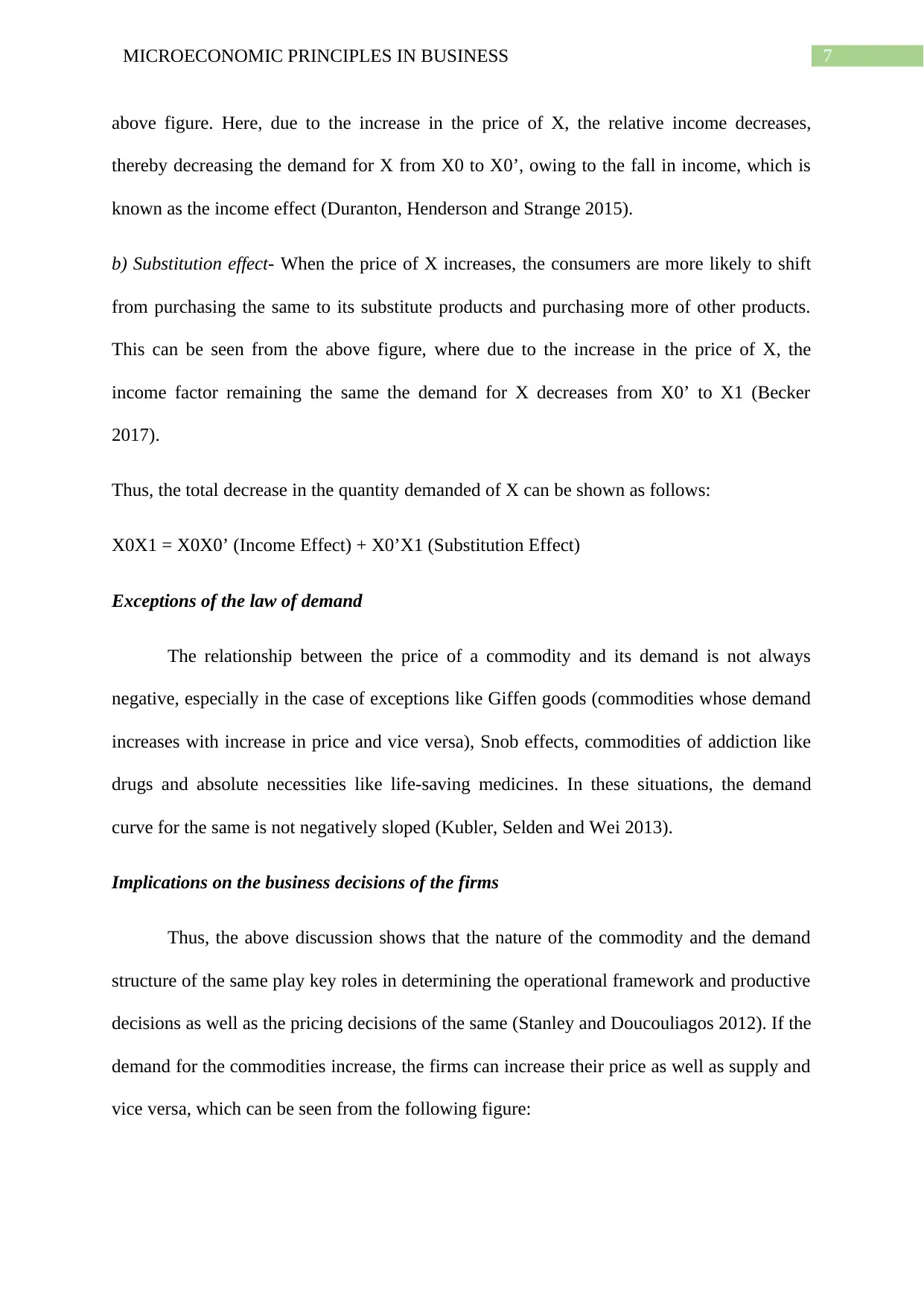
7MICROECONOMIC PRINCIPLES IN BUSINESS
above figure. Here, due to the increase in the price of X, the relative income decreases,
thereby decreasing the demand for X from X0 to X0’, owing to the fall in income, which is
known as the income effect (Duranton, Henderson and Strange 2015).
b) Substitution effect- When the price of X increases, the consumers are more likely to shift
from purchasing the same to its substitute products and purchasing more of other products.
This can be seen from the above figure, where due to the increase in the price of X, the
income factor remaining the same the demand for X decreases from X0’ to X1 (Becker
2017).
Thus, the total decrease in the quantity demanded of X can be shown as follows:
X0X1 = X0X0’ (Income Effect) + X0’X1 (Substitution Effect)
Exceptions of the law of demand
The relationship between the price of a commodity and its demand is not always
negative, especially in the case of exceptions like Giffen goods (commodities whose demand
increases with increase in price and vice versa), Snob effects, commodities of addiction like
drugs and absolute necessities like life-saving medicines. In these situations, the demand
curve for the same is not negatively sloped (Kubler, Selden and Wei 2013).
Implications on the business decisions of the firms
Thus, the above discussion shows that the nature of the commodity and the demand
structure of the same play key roles in determining the operational framework and productive
decisions as well as the pricing decisions of the same (Stanley and Doucouliagos 2012). If the
demand for the commodities increase, the firms can increase their price as well as supply and
vice versa, which can be seen from the following figure:
above figure. Here, due to the increase in the price of X, the relative income decreases,
thereby decreasing the demand for X from X0 to X0’, owing to the fall in income, which is
known as the income effect (Duranton, Henderson and Strange 2015).
b) Substitution effect- When the price of X increases, the consumers are more likely to shift
from purchasing the same to its substitute products and purchasing more of other products.
This can be seen from the above figure, where due to the increase in the price of X, the
income factor remaining the same the demand for X decreases from X0’ to X1 (Becker
2017).
Thus, the total decrease in the quantity demanded of X can be shown as follows:
X0X1 = X0X0’ (Income Effect) + X0’X1 (Substitution Effect)
Exceptions of the law of demand
The relationship between the price of a commodity and its demand is not always
negative, especially in the case of exceptions like Giffen goods (commodities whose demand
increases with increase in price and vice versa), Snob effects, commodities of addiction like
drugs and absolute necessities like life-saving medicines. In these situations, the demand
curve for the same is not negatively sloped (Kubler, Selden and Wei 2013).
Implications on the business decisions of the firms
Thus, the above discussion shows that the nature of the commodity and the demand
structure of the same play key roles in determining the operational framework and productive
decisions as well as the pricing decisions of the same (Stanley and Doucouliagos 2012). If the
demand for the commodities increase, the firms can increase their price as well as supply and
vice versa, which can be seen from the following figure:
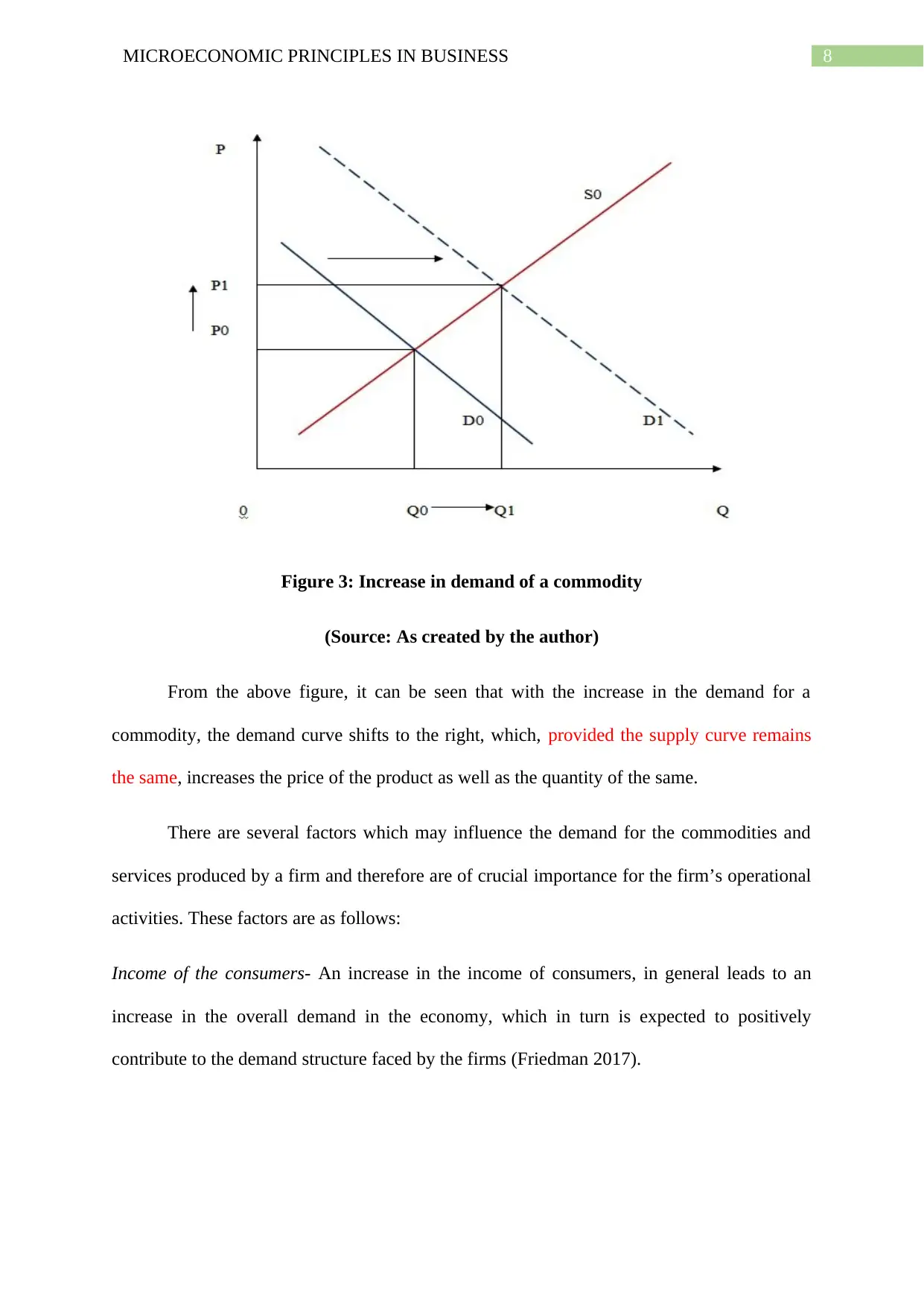
8MICROECONOMIC PRINCIPLES IN BUSINESS
Figure 3: Increase in demand of a commodity
(Source: As created by the author)
From the above figure, it can be seen that with the increase in the demand for a
commodity, the demand curve shifts to the right, which, provided the supply curve remains
the same, increases the price of the product as well as the quantity of the same.
There are several factors which may influence the demand for the commodities and
services produced by a firm and therefore are of crucial importance for the firm’s operational
activities. These factors are as follows:
Income of the consumers- An increase in the income of consumers, in general leads to an
increase in the overall demand in the economy, which in turn is expected to positively
contribute to the demand structure faced by the firms (Friedman 2017).
Figure 3: Increase in demand of a commodity
(Source: As created by the author)
From the above figure, it can be seen that with the increase in the demand for a
commodity, the demand curve shifts to the right, which, provided the supply curve remains
the same, increases the price of the product as well as the quantity of the same.
There are several factors which may influence the demand for the commodities and
services produced by a firm and therefore are of crucial importance for the firm’s operational
activities. These factors are as follows:
Income of the consumers- An increase in the income of consumers, in general leads to an
increase in the overall demand in the economy, which in turn is expected to positively
contribute to the demand structure faced by the firms (Friedman 2017).
⊘ This is a preview!⊘
Do you want full access?
Subscribe today to unlock all pages.

Trusted by 1+ million students worldwide
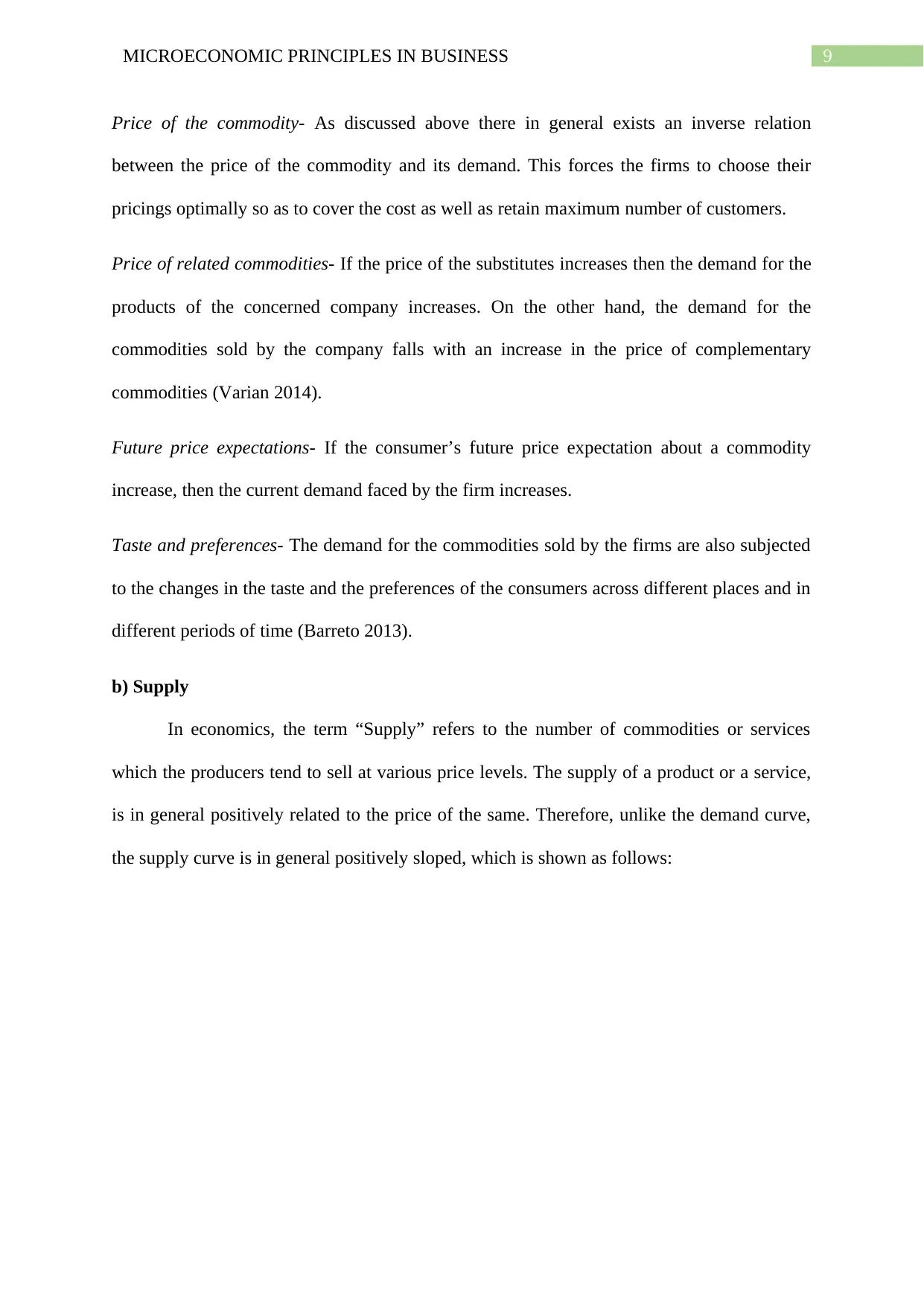
9MICROECONOMIC PRINCIPLES IN BUSINESS
Price of the commodity- As discussed above there in general exists an inverse relation
between the price of the commodity and its demand. This forces the firms to choose their
pricings optimally so as to cover the cost as well as retain maximum number of customers.
Price of related commodities- If the price of the substitutes increases then the demand for the
products of the concerned company increases. On the other hand, the demand for the
commodities sold by the company falls with an increase in the price of complementary
commodities (Varian 2014).
Future price expectations- If the consumer’s future price expectation about a commodity
increase, then the current demand faced by the firm increases.
Taste and preferences- The demand for the commodities sold by the firms are also subjected
to the changes in the taste and the preferences of the consumers across different places and in
different periods of time (Barreto 2013).
b) Supply
In economics, the term “Supply” refers to the number of commodities or services
which the producers tend to sell at various price levels. The supply of a product or a service,
is in general positively related to the price of the same. Therefore, unlike the demand curve,
the supply curve is in general positively sloped, which is shown as follows:
Price of the commodity- As discussed above there in general exists an inverse relation
between the price of the commodity and its demand. This forces the firms to choose their
pricings optimally so as to cover the cost as well as retain maximum number of customers.
Price of related commodities- If the price of the substitutes increases then the demand for the
products of the concerned company increases. On the other hand, the demand for the
commodities sold by the company falls with an increase in the price of complementary
commodities (Varian 2014).
Future price expectations- If the consumer’s future price expectation about a commodity
increase, then the current demand faced by the firm increases.
Taste and preferences- The demand for the commodities sold by the firms are also subjected
to the changes in the taste and the preferences of the consumers across different places and in
different periods of time (Barreto 2013).
b) Supply
In economics, the term “Supply” refers to the number of commodities or services
which the producers tend to sell at various price levels. The supply of a product or a service,
is in general positively related to the price of the same. Therefore, unlike the demand curve,
the supply curve is in general positively sloped, which is shown as follows:
Paraphrase This Document
Need a fresh take? Get an instant paraphrase of this document with our AI Paraphraser
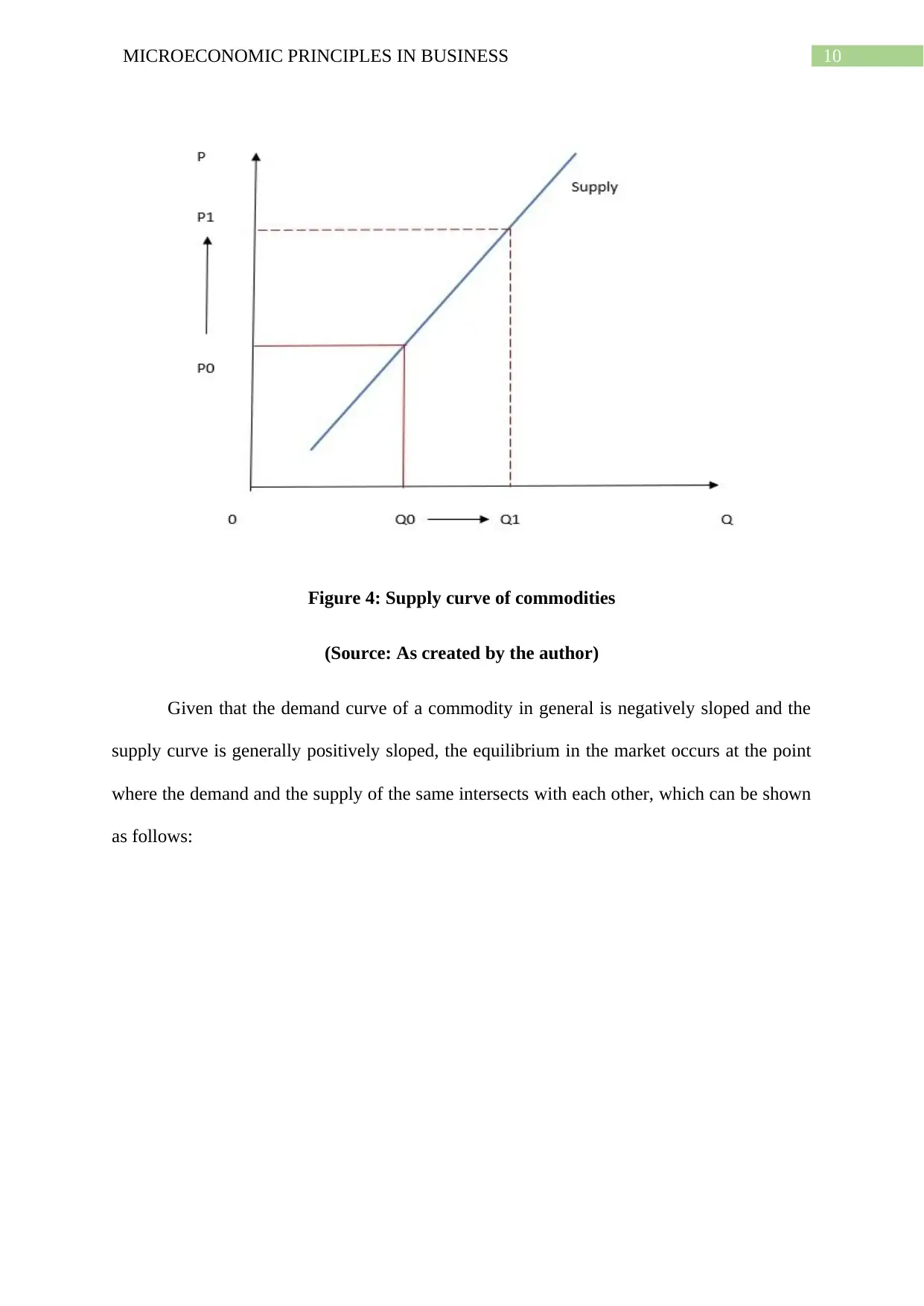
10MICROECONOMIC PRINCIPLES IN BUSINESS
Figure 4: Supply curve of commodities
(Source: As created by the author)
Given that the demand curve of a commodity in general is negatively sloped and the
supply curve is generally positively sloped, the equilibrium in the market occurs at the point
where the demand and the supply of the same intersects with each other, which can be shown
as follows:
Figure 4: Supply curve of commodities
(Source: As created by the author)
Given that the demand curve of a commodity in general is negatively sloped and the
supply curve is generally positively sloped, the equilibrium in the market occurs at the point
where the demand and the supply of the same intersects with each other, which can be shown
as follows:
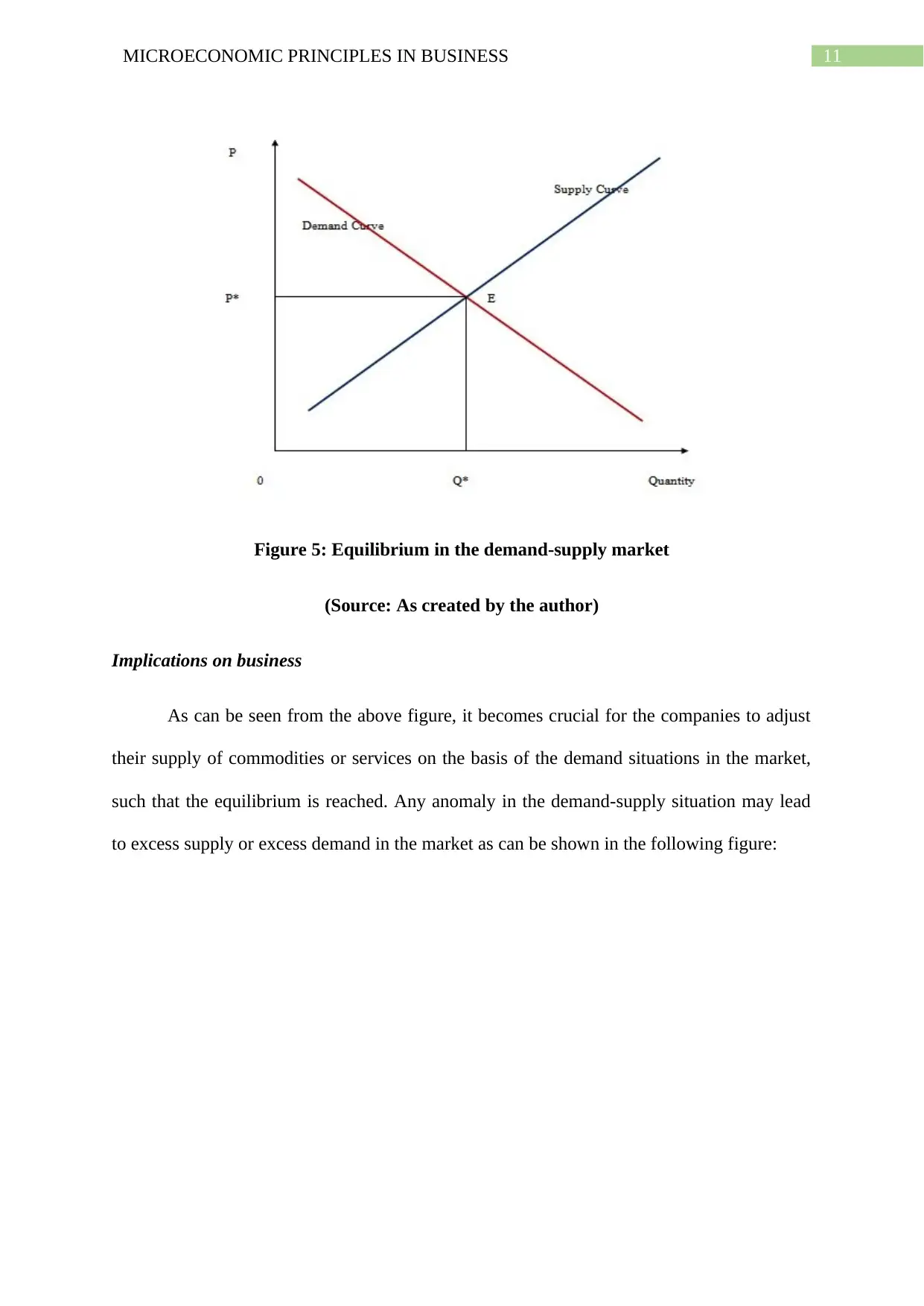
11MICROECONOMIC PRINCIPLES IN BUSINESS
Figure 5: Equilibrium in the demand-supply market
(Source: As created by the author)
Implications on business
As can be seen from the above figure, it becomes crucial for the companies to adjust
their supply of commodities or services on the basis of the demand situations in the market,
such that the equilibrium is reached. Any anomaly in the demand-supply situation may lead
to excess supply or excess demand in the market as can be shown in the following figure:
Figure 5: Equilibrium in the demand-supply market
(Source: As created by the author)
Implications on business
As can be seen from the above figure, it becomes crucial for the companies to adjust
their supply of commodities or services on the basis of the demand situations in the market,
such that the equilibrium is reached. Any anomaly in the demand-supply situation may lead
to excess supply or excess demand in the market as can be shown in the following figure:
⊘ This is a preview!⊘
Do you want full access?
Subscribe today to unlock all pages.

Trusted by 1+ million students worldwide
1 out of 20
Related Documents
Your All-in-One AI-Powered Toolkit for Academic Success.
+13062052269
info@desklib.com
Available 24*7 on WhatsApp / Email
![[object Object]](/_next/static/media/star-bottom.7253800d.svg)
Unlock your academic potential
Copyright © 2020–2025 A2Z Services. All Rights Reserved. Developed and managed by ZUCOL.





